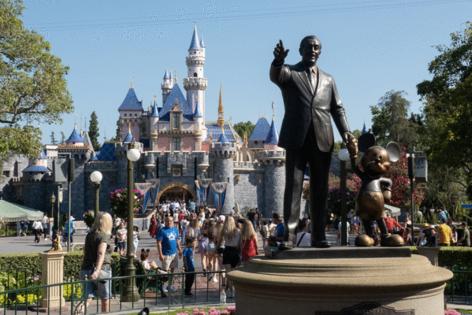Why Disney is doubling down on theme parks with a $60 billion plan
Published in Business News
Over the decades since Walt Disney opened his first theme park in 1955, the company's tourism business has ballooned to an enterprise worth tens of billions in yearly sales, with sprawling locations in Anaheim, Orlando, Paris, Shanghai, Hong Kong and Tokyo.
Today, the entertainment giant is doubling down once again. Disney plans to invest $60 billion over 10 years into its so-called experiences division, which includes the theme parks, resorts and cruise line, as well as merchandise.
In Anaheim, the city council recently approved an expansion plan at Disneyland Resort, which could lead to at least $1.9 billion of development and involve new attractions alongside hotel, retail and restaurant space.
Why the massive investment? At a time when Disney faces revenue challenges due to cord cutting, streaming wars and a slower film box office, its theme parks are a bright — and reliable — spot for its business. Moreover, they play a major part in the company's strategy — using well-loved movies to inspire rides and vice versa (think "Pirates of the Caribbean"), feeding an ongoing virtuous cycle.
"When you consider other elements of Disney's business, those theme parks, they've shown themselves to be proven winners," said Carissa Baker, assistant professor of theme park and attraction management at the University of Central Florida's Rosen College of Hospitality Management. "There's no doubt that they have stayed very competitive in the film space and the TV space, but they've always led the theme park sector."
During the most recent fiscal year, the company's experiences division — which is heavily anchored by the parks — brought in about 70% of Disney's operating income, according to a filing with the U.S. Securities and Exchange Commission. By contrast, Disney's sports sector, including ESPN, contributed 19% of operating income. The entertainment division, consisting of the company's TV channels, streaming services and movie studios, brought up the rear at 11%.
Those numbers represent a stark contrast from even 10 years ago, when the company was heavily reliant on its TV networks, which brought in 56% of Disney's operating income (that segment included ESPN at the time). The parks and resorts division drew just 20%.
The tide began to turn in 2019, as the global theme park industry saw record-breaking attendance, just in time for the pandemic to hit the next year.
With the parks closed, Disney reported an operating loss of $81 million in 2020. Disneyland and Disney's California Adventure, in particular, were shut for 15 months, due to tight restrictions in the Golden State. Since then, pent-up demand from visitors has propelled theme park revenue in a way that hasn't been replicated in movie theaters.
"The industry was really growing quickly before COVID-19, and that obviously put a crimp on everything," said Martin Lewison, associate professor of business management at Farmingdale State College in New York. "But it appears as long as the economy remains healthy, the industry is back on track for that growth."
...continued
©2024 Los Angeles Times. Visit at latimes.com. Distributed by Tribune Content Agency, LLC.







Comments